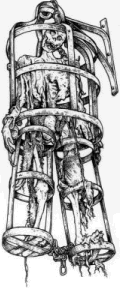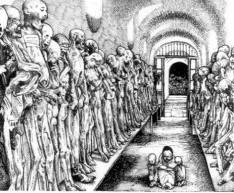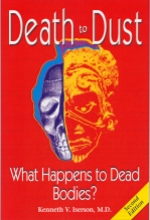October
2001, pages 293-94
DEATH
TO DUST
Death to Dust: What Happens to Dead Bodies?
KV Iserson, MD, 2nd edition
Galen Press Ltd, PO Box 64400, Tucson, AZ, 2001,
821pp, index, ISBN 1 883620 22 8; $48.95
Having
read my -foolish? -observation in the April edition
of this journal that the book I there reviewed had only 79
pages of text, the Editor (God bless you, Sir, God bless
you) sent to me this more than one kilogram work, the dust
jacket of which proclaims that it encompasses "Everything
you always wanted to know about corpses. . .".
Dr
Iserson is a medic (with a MD), an American, a realist,
and an enthusiast, not least for organ donation. This work is
more a collection of essays than a book, although the whole
is greater than the sum of its parts. Nonetheless, each of the
fourteen chapters, or essays, may profitably be read alone,
and many, if not all, will have separate natural audiences.
Dr
Iserson considers what is death, by brain criteria and
otherwise, and cites a 1994 Florida case where unemployed
parents sought Medicaid funding to keep "alive" their
plainly brain dead teenage daughter. However, he
recognises that errors have been (and still are) made in
diagnosing death, and records several cases of premature
diagnosis of death, and premature funerals and autopsies.
Dealing with "real" death, Dr Iserson describes post-
mortem changes, autopsies, and identification of cadavers.
He considers funerals, from Neanderthal, through ancient,
to modem, and from the third world to the most expensive
contemporary American funerals; in God's own country,
where the living may travel from log cabin to White House,
there are significant class distinctions in death. He
considers also religious rites, requirements and
prohibitions, humanist funerals, expenses, and public health
aspects of funeral rituals.
An
early chapter (essay) explains the benefits of autopsies,
and the great advantages of organ transplants. The reader
learns that in modem America blacks and Hispanics are
significantly less likely than whites to donate organs, as s/he
learns that in Europe presumed consent laws have
significantly increased organ donation. Dr Iserson considers
what may usefully be done to make more organs available
for transplants.
The
thousands of references demonstrate the width of Dr
Iserson's reading. The essays are erudite and thought-
provoking, and must be of interest to all medics, those
planning to read medicine, coroners, clergy and, more
generally, philosophers, historians and students of
humankind.
L
ES Hooper
JAMA
Journal
of the American Medical Association
October 10, 2001-Vol 286, No. 14 1767-8
BOOKS,
JOURNALS, NEW MEDIA
Death
to Dust: What Happens to Dead Bodies?
by
Kenneth V. Iserson, 2nd ed, 820 pp,
$48.95, ISBN 1-883620-22-8, Tucson, Ariz, Galen Press, 2001.
WHEN
THE FIRST EDITION OF THIS BOOK became available, one of the forensic
pathologists in our office purchased a copy. Several others, myself
included, followed suit. Why? Because we are busy medical examiners
who investigate and certify approximately 20% of all deaths in
our community, a figure that holds true in most medical examiner
and coroner jurisdictions. We know a lot about investigating and
determining causes of death. We know much about what happens to
dead bodies left unattended in various environmental conditions.
We know some embalming techniques. We know what funeral directors
do. We encounter varying human reactions when sudden death strikes
a family member. Yet we know little about what happens outside
our immediate experience. That is why we find Death to Dust both
fascinating and informative. It summarizes the historical, sociological,
and cultural variations in human reactions to death. It has something
for everyone: making funeral arrangements for family members,
use of cadavers in research for engineers, litigation involving
the dead for attorneys, plots for writers of fiction, customs
for sociologists, historical events for historians, and so forth.
Physicians will find it a useful shelf reference when dealing
with distraught families. The curious reader will enjoy picking
and choosing among the various topics.
 My
first question upon encountering this book concerned who wrote
it and why. Kenneth V. Iserson, MD, is professor of surgery and
practices emergency medicine at the University of Arizona Health
Sciences Center, directs the center's bioethics program, and is
medical director for a major search and rescue operation. Dr.
Iserson wanted to know more about what happens after death. Complex
ethical issues arise when one must explain to distraught families
why the patient died or when discussing organ and tissue donations,
but information was scattered and not readily available. Iserson's
desire to learn what he did not know has resulted in a single
useful resource with more than 2600 citations. The book is detailed
yet easy to read. The author intersperses medical information
with history and literature and apt quotations from many sources,
including the bible and Shakespeare. One may study a single subject,
such as modern embalming or how Lenin's body is kept presentable
for public viewing, or selectively read humorous tidbits of historical
and literary fact and folklore.
My
first question upon encountering this book concerned who wrote
it and why. Kenneth V. Iserson, MD, is professor of surgery and
practices emergency medicine at the University of Arizona Health
Sciences Center, directs the center's bioethics program, and is
medical director for a major search and rescue operation. Dr.
Iserson wanted to know more about what happens after death. Complex
ethical issues arise when one must explain to distraught families
why the patient died or when discussing organ and tissue donations,
but information was scattered and not readily available. Iserson's
desire to learn what he did not know has resulted in a single
useful resource with more than 2600 citations. The book is detailed
yet easy to read. The author intersperses medical information
with history and literature and apt quotations from many sources,
including the bible and Shakespeare. One may study a single subject,
such as modern embalming or how Lenin's body is kept presentable
for public viewing, or selectively read humorous tidbits of historical
and literary fact and folklore.
The book is arranged
logically, beginning with why death occurs and related questions.
Is apoptosis within cells the answer or only a hint? Navajo folklore
seems more pragmatic: "If we all live and continue to increase
as we have done in the past, the earth will be too small to hold
us and there will be no room for the cornfields." One learns
that, considering the potential for metabolic recovery of many
cells and organs, the moment of death is difficult to define.
The pronouncement of death is fraught with error, as numerous
case examples attest. What we take for granted may not be that
simple. How do we determine the difference between brain death
and persistent vegetative state and explain it to a patient's
anxious relatives? What happens to dead bodies? How do they decay
and disintegrate under different conditions? Definitions of brain
death are the prelude to a thorough discussion of organ, tissue,
and whole body donations. We learn that pre Christian era writings
describe skin grafting. Discussed thoroughly is the current status
of organ and tissue transplantation, including donors, recipients,
and changes in religious dogmas that facilitate donation and transplantation
in most of the world. Data on recipient needs and donor shortages
are presented for the year 2000. Donation and use of cadavers
for dissection end this chapter, which in itself is worth the
value of the book for physicians who may become involved in an
organ donation question. The next chapters present intricate details
of autopsy permission and methods and the unfortunate decline
in autopsies.
"Beauty in Death"
tells about embalming from its inception to the present. Details
about funerals are well presented. For those interested in archeology,
the mummification sections are enlightening. Historical aspects
of cremation in all cultures and the role of physicians to further
its use are edifying. The converse to flames is cryonics, the
freezing and preservation of bodies or heads for future reanimation.
Is it hoax, fraud, or cult? Does it have any legal or scientific
basis? The answers are detailed in the chapter "Souls on
Ice." "Wayward Bodies" explores what happens when
bodies are buried at sea or lost in space and points in between.
Legal requirements of transport of bodies across state or international
boundaries are discussed. "Going Out in Style" and "Black
Tie Affairs" cover funeral customs of the rich, famous, and
not so famous in many places over time. How may one be buried
in a veterans' cemetery? How have cemeteries evolved over time?
Planning for one's funeral is presented in detail, well worth
reading from an unbiased source that includes in the appendices
legal documents dealing with the laws designed to prevent fiscal
abuses. The final chapter features delightful quotations dealing
and classical epitaphs. The last is that of Mel Blanc, the voice
of Bugs Bunny, Tweety Bird, Daffy Duck, Woody Woodpecker, Porky
Pig, and other famous cartoon characters: "That's all folks."
The second edition follows the format of the first. It has 111
more pages with chapter page increases of 10% to 30%. An exception
is "Nightmares," which deals with cannibalism and sacrifices;
fortunately, not much of such ilk has occurred since the first
edition. Most new material, including newspaper references, covers
the eightyear period since the first edition. Each chapter heading
is followed by a list of 20 to 25 questions whose answers appear
in subsections that follow. The style makes for easy reading,
but the book does not read like a novel. Rather, one may study
in great detail a topic of special interest. Initially one should
browse, pausing to learn the amazing things that the human race
has done and is still doing when a member has died. Death to Dust
would grace any library shelf and makes a most unusual gift.

Joseph
H. Davis, MD, Miami, Fla
What
critics said about the first edition:
"Best
Reference Work of 1994"
New York Public Libraries
"Probably
one of the funniest, but most informative, books yet written on
mankind's many misguided methods of dealing with decaying human
hotels once the spirit has paid its bill and checked out. . .
. a highly readable, wonderfully entertaining (and frequently
hilarious) account of one of the only taboo subjects left in this
tell-Oprah-all society."
Betty Webb, Arizona Tribune.
"Dr.
Iserson's massive, comprehensive volume is easily the best work
on the subject that has appeared in recent years, and it is written
with a fluency that makes it accessible to the lay reader as well
as the professional." Jessica Mitford, The American Way of
Death Revisited.
"A
brilliantly researched, eminently readable, and encyclopedically
enjoyable book . . ."
Jacek B. Franaszek, The American Journal of Emergency Medicine
Fascinating
facts from Death to Dust: What Happens to Dead Bodies?
After
cremation, the "ashes" weigh an average of 7.4 pounds
for men and 5.8 pounds for women.
Embalming
a body for public viewing is an American cultural phenomenon.
In other parts of the world, it is considered so unusual (and
distasteful) that a special permit is required.
The
Warramunga tribe of Australia buried their dead in the branches
of trees, rubbing themselves with the fluids of the corpse as
a sign of mourning.
An
unembalmed adult body buried six-feet deep in ordinary soil without
a coffin normally takes ten to twelve years to decompose to a
skeleton
Eyes
are the most commonly donated organ. Approximately 43,000 corneal
transplants are done in a year.
About
2,500 Americans die every year while awaiting transplantation.
Blanch
White was the first recorded undertaker in the American Colonies,
establishing an undertaking and upholstery business in 1768.
In
Sweden, an unmarried woman is customarily buried with a mirror
so she can arrange her hair on Resurrection Day.
Approximately
150,000 maggots can be found on an exposed corpse.
U.S.
forces in Somalia in 1992 were the first to have "genetic
dog tags," blood samples and mouth scrapings allowing identification
even if only a scrap is left.
The
embalmed corpse of a 2,100-year-old "Chinese Princess"
revealed she suffered from heart and gallbladder disease, three
kinds of internal parasites, tuberculosis, and arthritis of the
spine.
A
winding sheet is a cloth wrapped around a corpse until burial
Before
New York passed the "anatomy act" in 1854, grave robbers
emptied 600 to 700 graves annually around New York City to supply
medical schools.
Many
Civil War-era photographers moved the corpses of dead soldiers
to make more interesting pictures.
The
gibbet was a cage used to hold the corpses of criminals upright
while they decomposed in public. The famous Parisian gibbet accommodated
45 corpses and was surrounded by taverns and gardens.
During
World War II, U.S. soldiers collected and preserved Japanese skulls
as table ornaments for their sweethearts.
If
it be certain as Galen says-
And sage Hippocrates holds as much-
That those afflicted by doubts and dismays
Are mightily healed by a dead man's touch.
-Rudyard Kipling
TABLE
OF CONTENTS
Extras:
Sample Advance Directives
Death Investigation Factoids
DECOMPOSITION
Funeral Industry Jargon
ORGAN AND WHOLE-BODY DONATION CARDS
"The Worm Song"
A Sample Protocol to Use When Speaking
With Survivors
Expected
versus Sudden, Unexpected Deaths (Table 1-1)
Treating
President Lincoln's Fatal Head Wound
DEATHS
FROM BATTLE AND DISEASE IN AMERICAN WARS
SOULS
ON ICE
DOWNLOAD
PDF FILES:
After
Death Planning Guide (Requires Acrobat
Reader)



 Death
to Dust: What Happens to Dead Bodies? provides the answers to
the questions about corpses you were afraid to ask: How does a
body really turn to dust? What happens during autopsies, dissection,
embalming, cremation, and cryogenic preservation? And what about
cannibalism, body snatching, and the secret rites of various cultures?
Death
to Dust: What Happens to Dead Bodies? provides the answers to
the questions about corpses you were afraid to ask: How does a
body really turn to dust? What happens during autopsies, dissection,
embalming, cremation, and cryogenic preservation? And what about
cannibalism, body snatching, and the secret rites of various cultures?
 My
first question upon encountering this book concerned who wrote
it and why. Kenneth V. Iserson, MD, is professor of surgery and
practices emergency medicine at the University of Arizona Health
Sciences Center, directs the center's bioethics program, and is
medical director for a major search and rescue operation. Dr.
Iserson wanted to know more about what happens after death. Complex
ethical issues arise when one must explain to distraught families
why the patient died or when discussing organ and tissue donations,
but information was scattered and not readily available. Iserson's
desire to learn what he did not know has resulted in a single
useful resource with more than 2600 citations. The book is detailed
yet easy to read. The author intersperses medical information
with history and literature and apt quotations from many sources,
including the bible and Shakespeare. One may study a single subject,
such as modern embalming or how Lenin's body is kept presentable
for public viewing, or selectively read humorous tidbits of historical
and literary fact and folklore.
My
first question upon encountering this book concerned who wrote
it and why. Kenneth V. Iserson, MD, is professor of surgery and
practices emergency medicine at the University of Arizona Health
Sciences Center, directs the center's bioethics program, and is
medical director for a major search and rescue operation. Dr.
Iserson wanted to know more about what happens after death. Complex
ethical issues arise when one must explain to distraught families
why the patient died or when discussing organ and tissue donations,
but information was scattered and not readily available. Iserson's
desire to learn what he did not know has resulted in a single
useful resource with more than 2600 citations. The book is detailed
yet easy to read. The author intersperses medical information
with history and literature and apt quotations from many sources,
including the bible and Shakespeare. One may study a single subject,
such as modern embalming or how Lenin's body is kept presentable
for public viewing, or selectively read humorous tidbits of historical
and literary fact and folklore. 